by Michelle Sutton
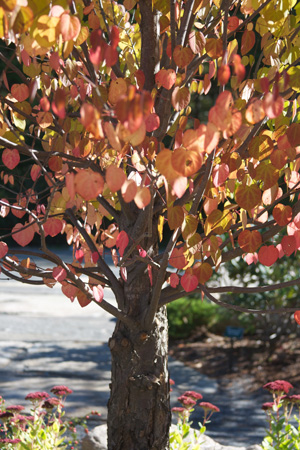
The timing of fall foliage color emergence is a phenophase that citizen scientists can track for Nature’s Notebook.
Gardeners on a Mission
Phenology is a rather clinical-sounding word that describes a passionate field of study. The word comes from the Latin root “pheno,” meaning “to appear” or “to bring to light,” and it refers to the timing of seasonal changes and life cycle events in the natural world. New York Phenology Project (nyphenologyproject.org) Founder and Project Manager Kerissa Battle says, “Gardeners are intuitive phenologists—even if they don’t know it! Skilled gardeners closely track seasonal change—their success in the garden depends on it.”
“Phenophases” are distinct life cycle events; for plants, they include such things as fall color emergence, fruiting, budding, flowering, and leafing out. “When gardeners start seeds, plant, harvest, or collect seeds, they are essentially tracking phenophases in order to grow what they want,” Battle says. “Gardeners also tend to keep records year to year of when things happen in their gardens. This is the essence of tracking phenology—paying close attention to seasonal change and keeping records.”
Across the country, more than 15,000 citizen scientists are tracking phenological data for a proscribed set of plants and animals. Many of them are gardeners collecting data from plants in their own gardens; others are going to designated “phenology trails” and other sites in the community. Many of them are entering their data in an elegant national endeavor utilizing Nature’s Notebook, a data-collecting tool of USA National Phenology Network (usanpn.org).
In 2015, New York Phenology Project (NYPP) observers contributed more than 10% of the national dataset. The national total number of observations recorded in Nature’s Notebook in 2015 was 1.8 million!
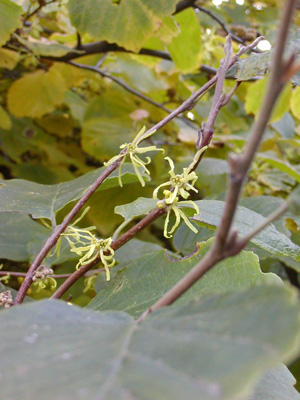
Phenology aficionados track “phenophases,” like bloom time of native witch hazel (Hamamelis virginiana). Photo by Michelle Sutton
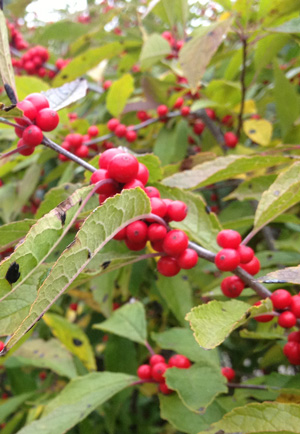
Time of fruitset, like on this winterberry holly (Ilex verticillata), is a phenophase that is tracked by phenologists. Photo by Michelle Sutton
The mission of Nature’s Notebook is to encourage close observation of nature, both for the joy of it and the data that results. Theresa Crimmins is assistant director at USA National Phenology Network. “As climate changes, the timing of these life cycle events also changes for many species. However, not all species are exhibiting changes, and the changes that are occurring are not all in the same direction or of the same magnitude.”
Crimmins says that the implications for this are wide-ranging and not yet completely realized, but include mismatches in the timing of open flowers and the arrival of pollinators, spread of invasive species, and changes in species ranges. “Local observations of phenology can provide critical data for scientists studying the effects of changing climate,” she says.
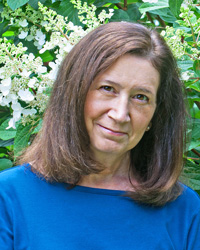
About.com Gardening Expert Marie Iannotti participates in phenology data collection for Nature’s Notebook and uses phenology in a variety of practical ways in her home garden. Photo courtesy Marie Iannotti
When the Lilac Leaves Unfurl…
One of those data collectors is garden writer, speaker, and photographer Marie Iannotti (gardeningthehudsonvalley.com), whose name may sound familiar because she is the gardening expert for About.com. She has written three books, including The Timber Press Guide to Vegetable Gardening in the Northeast.
Iannotti remembers getting phenology-based planting advice from an older gardener who advised her to “plant your potatoes when you spot the first dandelion.” She says, “I started poking around to see if this kind of advice was just folklore or if there was some research behind it. When I found out the research on phenology is ongoing and anyone could participate in tracking, I jumped in, and I started collecting all the tips that had to do with gardening.”
Iannotti takes part in the New York Phenology Project through Nature’s Notebook. She says, “Tracking phenology is a great way for gardeners to get to know the cycles of nature and which things tend to occur at the same point in time. I started by tracking lilacs and know that when the lilac leaves first start to unfurl, I can plant lettuce and carrots, and when the lilac blooms, it’s safe to plant cucumbers and beans. When the forsythia blooms, I plant peas. It’s not an infallible system, but it’s a great tool for planning and for increasing your knowledge of natural phenomena. And since weather can be so variable, it’s more accurate than counting backwards from your last expected frost date.”
According to Iannotti, phenology makes us more aware of not just the changes, but also when something is wrong. For instance, why would we suddenly be seeing so many grasshoppers, or an increase in poison ivy? When should we be on the alert for Japanese beetles? When will cabbage worms be hatching, so we remember to go looking for them? “I’m also tracking my garden nemesis, the groundhog,” she says.
Trails and Sites Near/by You
Kerissa Battle says that one of the great things about the New York Phenology Project (NYPP) is that anyone can create a monitoring site almost anywhere. “Even if you only have space for a container garden outside of your house, or you just tag one red maple on the street in front of your house, or you get permission from the town to mark plants on your favorite local trail—you can join this effort,” she says.
Currently most monitoring sites are situated downstate. Battle would like to see more phenology trails and monitoring sites get established in central and northern New York. “Phenology data has been used mostly to monitor long-term patterns,” she says. “However, if monitoring sites are situated along a gradient—such as north to south or urban to rural—the data collected becomes relevant in the short-term as well.” How does urbanization affect the timing of flowering? Are the same pollinators being seen along an urban-rural gradient? Battle says that an array of monitoring sites that represent all of New York’s diverse ecosystems would allow these types of questions to be addressed.
In addition, central and northern New York are home to some of our State’s finest organizations and academic institutions—many of whom are already well-positioned to set up a site and engage students and the public in citizen science. “Indeed some of the most beloved nature preserves and institutions in New York are already involved—and new monitoring sites pop up every year,” Battle says.
Lime Hollow Nature Center in Cortland recently established a one-mile phenology trail with a focus on five woody plants: red maple (Acer rubrum), sugar maple (A. saccharum), American beech (Fagus grandifolia), witch hazel (Hamamelis virginiana), and eastern red cedar (Juniperus virginiana). They are also tracking the wonderful herbaceous woodland forb, skunk cabbage (Symplocarpus foetidus).
The Finger Lakes Land Trust (FLLT), based in Ithaca, set up a phenology trail in Roy H. Park Preserve in Dryden, where they are monitoring red and sugar maple as well as black cherry (Prunus serotina), Eastern white pine (Pinus strobus), quaking aspen (Populus tremuloides) and Eastern hemlock (Tsuga canadensis). They are looking for more volunteers to get involved with this phenology trail. The FLLT has an intimate history with phenology; one of its founders and its first president was Carl Leopold, son of beloved naturalist and author Aldo Leopold, who was an avid phenology data collector.
According to the FLLT website:
While Aldo is well-known for his phenological observations at his farm and shack in Wisconsin from 1935-1948, the whole family participated in observing nature … those observations have proved extremely important … years later, Aldo’s children Carl and Nina used Aldo’s records to publish a study in 1999 showing that temperature-dependent phenological events are occurring earlier. In 2013, a team of researchers used those same records to publish a new study on record-breaking early flowering in 2012. Just think—the observations you contribute today could lead to an important scientific paper down the road!
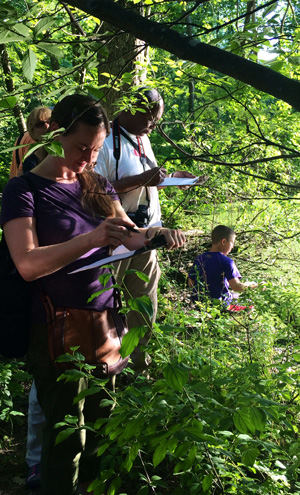
Citizen scientists around New York State are collecting phenology data and entering it into Nature’s Notebook. Photo by Kerissa Battle
A Bustling Play
Battle set up a phenology trail around her property (which includes her garden) and checks her plants nearly every day when she takes her dogs for a walk. “I get my exercise and slow down my mind while I take in everything I am observing,” she says. “It is meditative and enlivening all at the same time. What could be better?”
“Beyond the pure pleasure of phenology monitoring, you can also craft your garden or yard within the larger context of the surrounding ecosystem,” Battle says. She goes on:
You begin to notice the same pollinators on your tomatoes that you are observing on the milkweed in the field. You begin to notice that the red maples in your yard are flowering later than the red maples in town. You start wondering if the heavy fruit set on the mountain laurel near your garden is because your garden is so lush this year that native pollinators decided to nest nearby and are now pollinating everything in sight. What insects are arriving and when; what birds are hanging around your gardens; what else is in bloom near your garden that might be attracting pollinators?
Suddenly you realize that the pollinators are not just servicing your garden—you are actually feeding them. And then they are moving from your garden to the patch of wild bergamot down the road and the fertilized seeds of the wild bergamot are feeding the birds at the end of the summer, and bam! Your intentional watching has placed your garden in the center of a bustling play—with you as both actor and audience.
Battle encourages those who are interested in creating a new NYPP site—which could be in your backyard—to visit nyphenologyproject.org.
—Michelle Sutton (michellejudysutton.com) is a horticulturist, writer, and editor.
Views: 0






